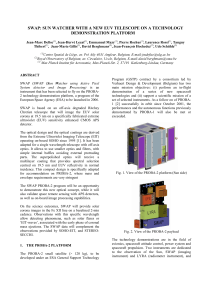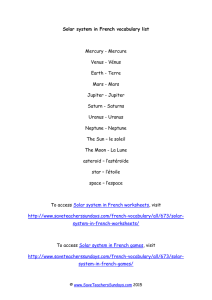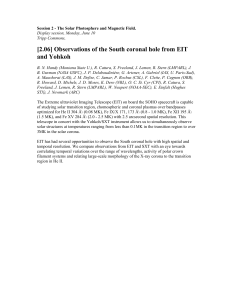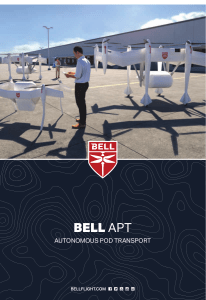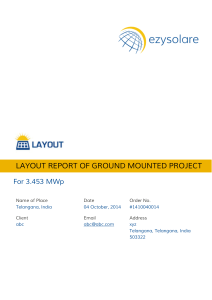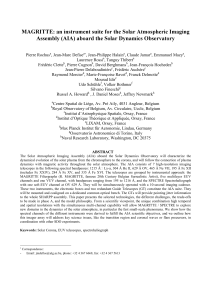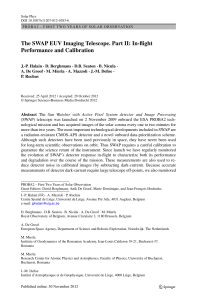Open access
publicité
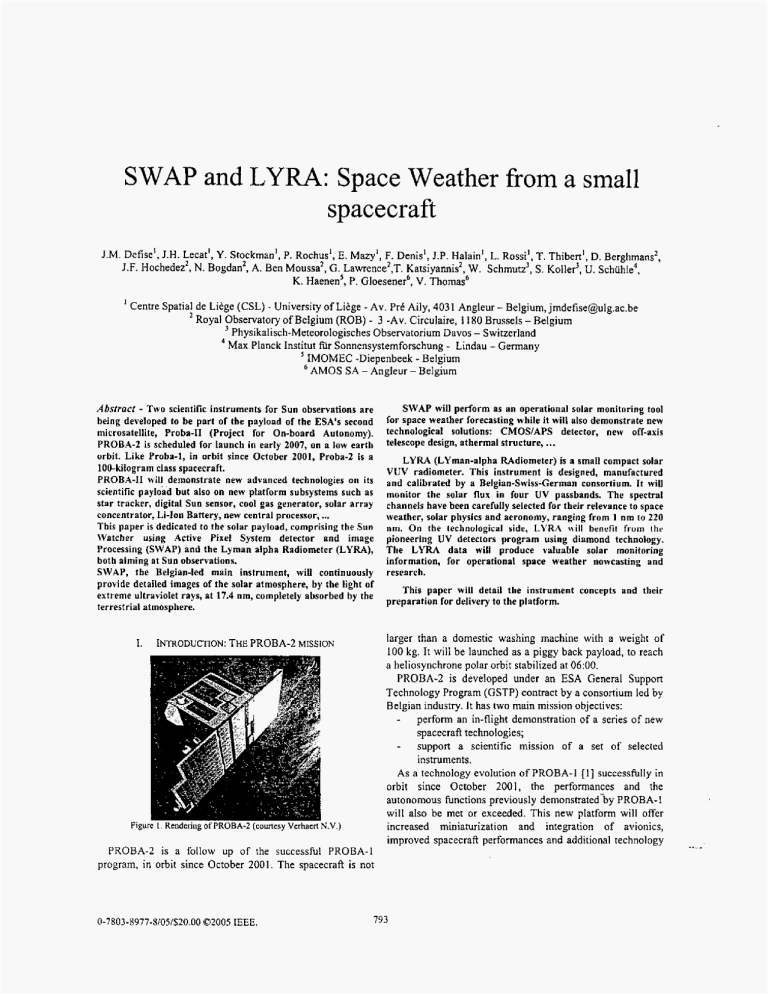
SWAP and LYRA: Space Weather from a small spacecraft J.M. Defise', J.H.Lecat', Y. Stockman', P. Rochus', E. Mazy', F. Denis', J.P. Halain', L. Ross?, T. Thibert', 0.Berghmans', J.F. Hochedez', N.Bogdan', A. Ben Moussa2,G . LawrenceZ,T.Katsiyannis2,W. Schmutz', S. Koller', U. Schuhle4, K. Haenen', P. Gloesener6, V. Thomas6 Centre Spatial de Liege (CSL) - University o f Liege - AV. Prt Aily, 4031 Angleur - Belgium,[email protected] Royal Observatory of Belgium (ROB) - 3 -AV.Circulaire, 1 I80 Brussels - Belgium Physikalisch-MeteorologischesObservatorium Davos - Switzerland Max Planck Institut f i r Sonnensystemforschung Lindau - Germany IMOMEC -Diepenbeek - Belgium 'AMOS SA - Angleur - Belgium - Absrrocr - Two scientific instruments for Sun observations are being developed to be part of the paylosd o f the ESA's second microsatellite, Proba-I1 (Project for On-board Autonomy). PROB.4-2 is scheduled for launch in early 2007, on a low earth orbit. Like Proba-1, in orbit since October 2001, Proba-2 is a 100-kilogram class spacecraft. PROBA-I1 will demonstrate new advanced technologies on its scientific payload but also on new platform subsystems such as star tracker, digital Sun sensor, cool gas generator, solar array concentrator, Li-Ion Battery, new central processor, ... This paper is dedicated to the solar payload, comprising the Sun Watcher using Active Pixel System detector and image Processing (SWAP) and the Lyman alpha Radiometer (LYRA), both aiming a t Sun observations. SWAP, rhe Belgian-led main instrument, will continuously provide detailed images of the solar atmosphere, by the light of extreme ultraviolet rays, at 17.4 nm, completely absorbed by the terrestrial atmosphere. I. INTRODUCTION: THE PROBA-2 MISSION SWAP will perform as an operational solar monitoring tool for space weather forecasting while it will also demonstrate new technological solutions: CMOSlAPS detector, new off-axis telescope design, athermal structure, ... LYRA (Lyman-alpha Mdiometer) i s a small compact solar VU\' radiometer. This instrument is designed, manufactured and calibrated by a Belgian-Swiss-German consortium. It will monitor the solar flux in four UV passbands. The spectral channels have been carefutly selected for their relevance io space weather, solar physics and aeronomy, ranging from 1 nm to 220 nm. On the technological 5ide, [.\'RA !\ill henufit from the pioneering UV detectors program using diamond technology. The LYRA data will produce valuable solar monitoring information, for operational space westher nowcasting and research. This papcr will detail the instrument concepts and their preparation for delivery to the platform. larger than a domestic washing machine with a weight of 100 kg. It will be launched as a piggy back payload, to reach a heliosynchrone polar orbit stabilized at 06:OO. PROBA-2 is developed under an ESA General Support Technology Program (GSTP)contract by a consortium led by Belgian industry. It has two main mission objectives: perform an in-flight demonstration of a series of new spacecraft technologies; - support a scientific mission of a set of selected I instruments. As a technology evolution of PROBA-1 [ I ] successfully in Figure 1 Kendeiiiig 01 PROBA-? (courtcry Verhdcrl \ V ) orbit since October 2001, the performances and the autonomous functions previously demonstrated'by PROBA- 1 will also be met or exceeded. This new ptatform will offer increased miniaturization and integration of avionics, improved spacecraft performances and additional technology PROBA-2 is a follow up of the successhi PROBA-I program, in orbit since October 2001. The spacecraft is not 0-7803-8977-5105/%20.0002005 IEEE. 793 -*. - demonstration in the field of power system and propulsion, providing thus more resources to the payloads. PROBA-2 will be launched in 2007 Iogether with the SMOS spacecraft. The spacecraft will permanently orient its top face towards the Sun, allowing quasi-interrupted solar observations, besides the eclipse seasons. II. PROBA-2 PAYLOAD SWAP and LYRA are the major components of the PROBA-2 scientific payload [ 2 ] , both developed under the management of Centre Spatial de Libge (CSL, Belgium). SWAP will image the extreme UV solar corona with a dedicated telescope, while the LYRA radiometer will record the total solar radiation in four UV wavelength ranges. The Academy of Sciences of the Czech Republic is developing the other components of the scientific payload: - the Thermal Plasma Measurement Unit (TPMU) to evaluate the density and temperature of the ions, - the Dual Segmented Langmuir Probe (DSLP). These 4 instruments are developed in the frame of the PRODEXiESA program. LYIM systems on the Earth. Proba-2 itself will perform much of the analysis needed to spot the solar storms. SWAP will provide observations centered on the 17.4 nm emission h e . I t will give indeed a particularly broad view on the 'solar weather'. Single 17.4 nm images are expected to give important information on the location of coronal holes (the source of high speed solar wind streams), active regions (potential source of solar flares) and filaments (potential eruption sites). Following the temporal evolution of these features as they rotate, gives additional important inputs to space weather forecasters. SWAP will continue the systematic CME watch program of the aging EIT instrument, in a neighbor waveiength, that shall guarantee the detection of space weather related solar events. Most of these significant events last on the order of 30 min to 45 min. The SWAP time cadence will be of the order of 1 minute, which is well adapted to record the occurrence of these events. Thanks to this high image cadence, SWAP will be a sotar monitor capable of recording the time-evolution of every event in the low solar corona that might be of relevance to the soace wzarher. SWAP Figure 2. Open view o f the PROBA-? platform wtrh SWAP and LYRA payload (counesy Verhaert N.V.) I l l . SWAP INSTRUMENT Figurc 3 . The EUV solar corona seen by SOHOIEIT. It i s a rcalistic preview of the images that will be produced with SWAP. that will have e slighlly larger field of view (54 arcmin instead of45 for EIT) Usins the PRORA platform agility. the on-board detection o f Ubjec/ives CME will be used to trigger off-pointings in order to fallow SWAP [3] has been proposed as a successor of the Extreme ultraviolet Imaging Telescope 141 (EIT) onboard the joint and image the CME leaving the Sun. ESA-NASA mission SOHO. The latter monitors the solar corona since 1996. The EIT instrument has proved to be B. Inrmmenr Design particularly useful for space weather manitoring, thanks to its The optics and focal plane assemblies of the SWAP 'CME (Coronal Mass Ejections) watch program' providing an telescope will be mounted on an optical bench designed to EUV image every 15 min. provide mechanical stability and insensitivity to thermal Using techniques of solar observation devetoped by variations. Wirh lightweight Invar structure, a stability better scientists in Belgium, for ESA's Space Weather project. than 50 pm will remain between the 2 mirrors in all the SWAP and LYRA will give early warnings of eruptions on temperature range encountered by SWAP on-board the Sun that provoke stormy weather throughout the Solar PROBA-2. System. These often damage satellites and engineering SWAP is using a set.of flexible mounts for attachment on A. , Scieiitijic 794 ~ _.. the spacecraft to avoid platform perturbations and keep a stable optical bench. Figure 6. SWAP structure dynamic analysis Showing one of the first global vibration modes (colors scale corresponding to absolute displacements. the feet being hardmounted) Figure 4. SWAP sensor box, with its main dimensions. The insrmment is encased in a lightweight housing (Fig. 4) equipped with an aperture mechanism to preserve the optical cavity from extemal contamination during on-ground activities and launch phase. focal plane with The optical scheme is a novel off-axis Ritchey Chretien scheme, that will offer numerous advantages for SWAP: (i) smaller and lighter primary mirror (no central obscuration); (ii) smaller aluminum foil filter thus reduced risk of mechanical damages; (iii) easy and efficient baming system. The off-axis telescope i s illustrated in Fig. 7. A detailed description of the optical concept can b e found ia IS]. A connectors tk electronics Focal plane Figure 7 SWAP optical schcme The optics (Fig. 8J will be manufactured and polished with a microroughness below 0.5 nm by AMOS S.A. (Belgium); then glued in dedicated mounts, and coated by lnstitut d'Optique ThCorique et AppliquCe (IOTA, France). figure 5. SWAP optical bench with i t s subsystems: the 2 mirrors, the optical bench, lhe focal piane assembly and the optical bames. An apenure mechanism stands a1 t h e entrance of the ins:rumcnt fur cleanliness and filler protecrion on-groundand during launch. The SWAP structure is designed using standard finite element analyses (Fig. 6 ) in order to optimize the mass and the stiffness with the high stability requirement. It will be qualified with a structuraI model before the flight model manufacturing. Figure 8. SWAP mirror concept, view of a prototype model ( C O W ~ ~ ~ A Ms.A.) OS The optical coating is a multilayer composed of an altemance of -30 layers o f 2 different materials [6]. The overall stack is specifically designed to provide reflectivity in the extreme ultraviolet range and to achieve the spectral selection in a narrow band pass (1.5 nm) centered on 17.4 nm (Fig. 9 ) . 795 W. These 2 constrains are very demanding and required a deep optimization of the elecrronics as well as a lightweight mechanical structure. The assembly, integration and all the qualification tests will be performed in the facilities of CSL. The optical calibration with EUV radiation is performed in Germany (PTB Bessp). SWAP is expected to be delivered to the platform in the first half of 2006. 14 15 16 17 16 19 a Waveleoeth lnml The calibration of test detectors has already produced promising results (see Fig. 11). -.E Figure 9 . Reflectivity provided by the multilayer coating in the extreme UV range. The bandpass is -I 5 nm. with peak reflectivity of 40 %. The different plots correspond to the different incident angles. m (source: IOTA) The focal plane will include the CMOS APS detector [7] (Fig. I I ) from Fillfactory N.V. (Belgium), and a dedicated cold finger connected to an extemal radiator, viewing the cold OE-W 5E.W I E.W ?E109 lE.09 ]E+ )E.W space for passive cooling down to -2O'C. It is under E W incident p h i o w manufacturing at OIP N.V. (Belgium). The detector being Figure I I . SWAP test detector with scintitlalion coating (left) and permanently cooled, it will trap potential contaminants (right) the linearity check (0)with EUV photons, until reaching saturation released by the outgassing of the instrument surfaces in space, The horizontal plot [ 0 ) is the dark level. even with the high cleanliness level of SWAP. A decontamination hearer has been imptemented in order 10 Similar tests will be performed with the optics alone, and release these contaminants that are very critical for EUV with the fully integrated flight instrument in order to derive instruments. Periodic bake out sequences are planned in the the final calibration of SWAP images. SWAP operation plan. IV. LYRA INSTRUMENT Scien19c Objectives The Lyman-alpha Radiometer (LYRA) [8] [ 9 ] , a small compact solar VUV radiometer accompanies SWAP. LYRA i s designed, manufactured and calibrated by a Belgian-SwissGerman consortium led by CSL, with ROB being the principal investigator. Absolute measurements of the UV Sun irradiance are Figure IO. Focal plane assembly with its cwling radiator reputed to be difficult. They always require a space-born [courtesy OIP N V ) instrument. LYRA will be complementary to existing radiometers such as WARS, SEEITIMED, SORCE, ... by The focal plane assembly (Fig. IO) will also include the proximity electronics required to readout the sensor, and drive monitoring the solar flux in four carefully selected U V the calibration diodes. The proximity electronics is directly passbands. The channels have been chosen for their relevance connected to a specific memory compression and to aeronomy, space weather and solar physics: I/ Lymanpacketization module (MCPM) directly plugged in the central alpha (1 21.6 nm), 2/ the 200-220 nm Herzberg continuum computer of PROBA-2 (ADPMS). The MCPM and the range (interference filters for the two former passbands), 3/ AI proximity electronics are developed by Deltatec S.A. filter channels (1 7-70 nm) covering lie 11-30.4 nm, 4/ XUV Zr channels (1-20 nm), where solar variability is highest. (Belgium). A dedicated software running in the ADPMS will The LYRA data will produce valuable solar monitoring manage the SWAP data, with a compression module and a set information, for operational space weather nowcasting and of automatic event detection algorithms and data processing research. Similarly to SWAP, the LYRA science and (cosmic ray removal, weak pixel compensation, ...). SWAP and LYRA share the same power suppiy unit, operations will be managed by the solar team of the Royal named Interface Instrument Unit (IlU). This unit will be Observatory of Belgium (ROB), as principal investigator. mounted on the instrument panel between the 2 instruments. The I1U is built by AlcateVEtca (Belgium). B. Imirumenr Concept On the technological side, LYRA wil1 benefit from The spacecraft resources are very limited. SWAP mass is diamond detectors: it will be the first space assessment of the kiinited to IO kg, with a mean power dissipation lower than 5 pioneering U V detectors program, originally initiated at the A. ~ 796 A*'.- ROB. Diamond, the wide bandgap material, makes the sensors radiation-hard and "solar-blind", which allows suppressing the usual filrers, that block the unwanted visible, but attenuate seriously the desired UV radiation. LYRA has a set of 3 redundant heads, each including the 4 spectral channels. Each channel corresponds to a collimator and a detector head (one detector, one filter, two calibration LEDs and a calibrated hole). The design of the heads takes also into account opening angle, cleanliness, and thermal issues. The LYRA optical design by PhysikalischDavos (PMOD, Meteorologisches Observatorium Swizterland) stems from the photometers of VIRGO onboard S O H 0 [IO]. Figure [ 2 . A singk LYRA head with 4 spectral channels (radiation is coming from lower left side) du Nord (IEMN), tiile, France. TWO types of detectors are developed: - MSM (photoconductor with Metal-Semiconductor-Metal junction); - PiN (photodiod with p-i-n junction). Detectors based on CDV diamond consist of a thin epitaxial CVD diamond layer or an epitaxial mulritaver qtnrcnire deposited on a natural Ila or synthetic HPHT diamond substrate. CVD diamond PN junction and photoresistor have been optimized by mathematical modelling. The detector optimization included the improvement of the circular contact geometry, the photolithography process, the contact by laser and thermal annealing and the measurement of material and device parameters. Based on the various data sets gathered during the calibration campaigns (Fig. 14), the PiN diodes show good response in the Herzberg channel but are insensitive at the Lyman alpha wavelength. The MSM structures show higher responses with a solar blindness of typically 5 decades in magnitude between 200 and 400 nm. As for the PiN detectors, the responsivity drops by a factor 10 in Lyman alpha spectral region. The MSM are selected for the Lyman aIpha channel, where a signal of IO0 pA is expected and is manageable by the LYRA electronic. Alternative detectors are considered to provide a spare or a calibration backup in this channel. MSM with improved lithography mask or possibly Si detectors will equip the third LYRA head. Concerning the behavior in the X U V region. calibration tests performed at PTB Bessy svnchrotron give the preference to MSM detectors. i.501 I i.E-02 1.E-03 2 X B i.E-04 LE-05 CI: 5 I.€-06 4 I.€-07 Y 1.E-09 ' 0 F y r e 13. Open view of LYRA, without electronics. T h e 3 heads, each with 4 chaanels. are aligned each behind an aperture door (not shoNn). I00 200 300 400 500 6M) Wavelengrh (nm) Figure 14. Typical responsivities measured for PiN-diamond and MSM detectors The LYRA instmment has been optimized in ordcr to match the very strict platform requirements in terms of mass, power and thermal range. The overall mass of LYRA does not exceed 5 kg, its power is limited to 2.7 W and it can be operated in a [ 4 0 T, +6O"C] temperature range. Channel C. Detectors undjlters The LYRA solar blind diamond detectors are designed and fabricated at IMOMEC, Belgium with the collaboration of the National Institute for Materials Science (NIMS),Tsukuba, Japan and the lnstitut d'Electronique et de Microklectronique 797 Selected filter EUV I: 17-70 nm I AI foil filter on grid EUV 2: 1-20 nm I Zr foil filter on grid 7M, SO0 A dedicated spectral filter and caiibration LEDs complement each channel. The different filters are summarized in Table 1. The redundancy strategy uses 2 redundant heads. One is used on a weekly basis, while the other remains closed most of the time and is only used on a monthly basis. This will give all the relevant data to evaluate the aging of the sensors. D. Insmmmr developnienl LYRA design benefits from the heritage of the VIRGO experiment. Major efforts have been spent to characterize the new detectors in the spectral ranges of each channel. The solar blindness was also verified, as well as the transmission of the various filters. All these data were analyzed and compiled in order to build a radiometric model of the instrument. This tool was used to select the most adequate detectors for each channel to provide a useful solar signal. An engineering model of the LYRA instrument h a s been built and tested with a breadboard of the externat power electronics (Fig. IS). The assembly of the flight model will be completed in summer 2005. It will be followed by a full acceptance with vibrations and thermal vacuum tests. The complete instrument will undergo an end-to-end calibration. EMC (electromagnetic compatibility) verifications will be conducted with the IIU and the SWAP instrument before integration on the PROBA-2 platform. operational space weather observatory. The solar payload has been designed to provide - the demonstration of new technologies; valuable inputs for space weather forecasting; - data for new scientific researches; - a continuation to the solar survey of the aging SOH0 mission; - a support for the forthcoming SECCHliSTEREO mission [ 1 I],to be launched in 2006. SWAP and LYRA will contribute to demonstrating the feasibility o f a technology that will be highly beneficial'in the context of the Solar Orbiter ESA mission. New detectors, new compact optical scheme and on-board processing are key elements for this forthcoming ESA mission scheduled for the 201 1-2013 time frame. This makes the scientific payload also a key element in the PROBA-2 demonstrator. - VI. ~CK"IO\YI rT)T;MrhT< The instrument teams wish to thank ESA for taking into consideration the scientific outcomes of the payload to select a new launcher to reach a 06:OOorbit. The development of the SWAP instrument is funded by the Belgian Federal Science Policy Office (BELSPO), through the Belgium ESNPRODEX program. LYRA is developed with the support o f BELSPO, the Swiss Space Office (SSO) and the ESAPRODEX program. SWAP and LYRA receive development support from their German Co-Investigators. REFERENCES F. Teston et al. "PROBAr ESAi Auroriomy und Techriolugy IZemonrwu;ion Mission", Proceedings of the 13th Annual A I A . W S U , Conference on Small Satellites, August 23 - 26. 1999. [Z] 1'. Rochus, J.M. Detise e1 al PRUBA-II Payload: A Belgiuri Mini Space [4] Flgure 15. The engineering madel of LYRA with its breadboard power electronics V. CONCLUSIONS The development of the PROBA-2 payload is in very good progress, on both the technological side and the mission preparation. A new orbit has been obtained thanks to ESA, that will avoid eclipses of a 10:30 low earth orbit. This major improvement will really make LYRA and SWAP an weurlrer Observuruv, IAF 2004. 131 D. Berghmans er al, SWAP oil-board PROBA-2, a new EUV iniager/or soiar- rmonjioring, Submitted lo Advances in Space Research. Oct 2004. [4] JP. Delaboudini+re et al, €IT: Extreme-UV imugins relerrope Jnr the SOH0 mission; Solar Physics 162: 29 1-31 2. 1995. [j] J.M. Defise et ai, SI4'Afp: Suir wafcher ivirh a new EUV relcrcop on a Iechnolo.gy demniistrarion pluform: ICs0 Conference, 2004. 161 JP Chauvineau er al. "Descriprion arid performances of niir-rors and inu/ri/uy2rs for the e x ~ e m eullravialet i n i u g i y felescope (1517) of ihr S O H 0 n?ission". Proc. S P E 1546. 576. 171 H IXerickY cl a! "\'mir \MJ% (i// / t i c ior T.t.fO.T,i~'riw ; > I Y < * \ % " 111 11-t.1. CCD & AIS workshop, Brugge, Belgium, 5-7 June (19Y7); Proceedings p. PI. [SI J.-F. Hochedez er al, LYRA .' hfe/ody insrwmenr of Apollo Gruekgod o/ /he Liglrr and rhe Strrr, SWENET Warbhop (ESTEC)3-5 Nov 2003 191 J.F. Hochedez et al, LYRA; rhe Solar UY rudomerer obourd fhe ESA PROBA-2. Submined in Oct 2004. accepted for publication in COSPAR. I [IO]Frohhch e l 81, Solar Physics 162, p 101, 1995. [ 111J.D. Moses et al Strtr-Eurfh conneclion coronal and he/Iosphe17c iovesiigalion (SECCHI)for rhe NASA STEREO mission. SPlE 41 39-26, lul 2000. 798
